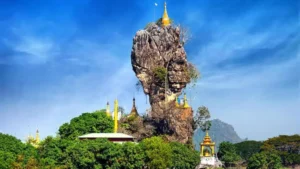Obsidian Stone: A Gem of Natural Beauty and Mystique 2024
Obsidian Stone , a captivating volcanic glass formed from rapidly cooled lava, has fascinated mankind for centuries with its striking appearance and metaphysical properties. This naturally occurring gemstone, revered by ancient civilizations and modern enthusiasts alike, holds a unique allure that transcends time and culture. Let’s delve into the enchanting world of Obsidian stone and uncover its secrets:

Formation and Characteristics:
Obsidian Stone is born from the intense heat and pressure of volcanic eruptions, where molten lava rapidly cools and solidifies into glassy rock. This rapid cooling process prevents the formation of crystalline structures, resulting in a smooth and uniform texture. Obsidian typically exhibits a shiny, black surface, although variations in color and transparency can occur, including shades of brown, red, blue, and green.
Cultural Significance:
Throughout history, Obsidian has held significant cultural and spiritual importance for civilizations around the world. Ancient peoples, including the Aztecs, Mayans, and ancient Egyptians, valued obsidian for its sharp edges, which made it ideal for crafting tools, weapons, and ceremonial objects. In Mesoamerica, Obsidian Stone was used in religious rituals and as a symbol of power and prestige.
Metaphysical Properties:
Obsidian Stone is revered in metaphysical circles for its purported healing and protective properties. Believed to possess grounding energy and psychic shielding abilities, obsidian is often used for spiritual purification, emotional healing, and energetic balance. Some practitioners use Obsidian Stone as a tool for meditation, inner reflection, and connecting with the subconscious mind.
Varieties and Types:
Obsidian Stone comes in several distinct varieties, each with its own unique characteristics and origins. Snowflake obsidian features white, snowflake-like inclusions of cristobalite, adding depth and texture to its appearance. Mahogany obsidian, characterized by its rich brown coloration, contains iron oxide impurities that create a warm and earthy hue. Rainbow Obsidian exhibits iridescent bands of color, caused by light refraction within the glassy matrix.

Uses in Jewelry and Decor:
Obsidian Stone sleek and lustrous appearance makes it a popular choice for jewelry and decorative objects. From polished cabochons and beads to carved figurines and sculptures, Obsidian Stone natural beauty is showcased in a variety of forms. Black obsidian, in particular, is prized for its elegant simplicity and versatility, making it a favored gemstone for statement pieces and minimalist designs.
Geological Significance:
Beyond its cultural and metaphysical significance, Obsidian provides valuable insights into the geological processes that shape our planet. The presence of Obsidian Stone deposits can protogel indicate past volcanic activity and the geological history of a region. Studying the composition and distribution of Obsidian Stone can help geologists understand volcanic eruptions, magma chemistry, and tectonic activity.
Conclusion:
Obsidian stone, with its timeless beauty and mystical allure, continues to captivate the imagination of people around the world. From its ancient origins as a tool of survival and spirituality to its modern-day uses in jewelry, decor, and metaphysical practice, obsidian remains a gem of natural wonder and fascination. Whether admired for its striking appearance, cherished for its metaphysical properties, or valued for its geological significance, obsidian stands as a testament to the enduring power and beauty of nature’s creations.
Pros and Cons of Obsidian Stone Stone: Understanding Nature’s Glass
Obsidian stone, a naturally occurring volcanic glass, possesses a unique allure that has captivated humans for millennia. Revered for its striking appearance and believed to hold metaphysical properties, obsidian boasts a range of advantages and disadvantages that make it both desirable and challenging to work with. Let’s explore the pros and cons of obsidian stone:

Advantages:
- Natural Beauty: Obsidian Stone glossy surface and deep, dark coloration lend it a natural beauty that is both striking and elegant. Its smooth texture and reflective properties make it a popular choice for jewelry, decorative objects, and architectural features.
- Hardness and Durability: Despite its glassy appearance, obsidian is surprisingly hard and durable. With a Mohs hardness rating of 5 to 5.5, obsidian is tougher than most natural glasses and can withstand scratching and abrasion better than softer gemstones.
- Metaphysical Properties: Obsidian Stone is revered in metaphysical circles for its purported healing and protective properties. Believed to possess grounding energy and psychic shielding abilities, obsidian is often used for spiritual purification, emotional healing, and energetic balance.
- Cultural and Historical Significance: Throughout history, obsidian has held significant cultural and spiritual importance for civilizations around the world. Ancient peoples valued Obsidian Stone for its sharp edges, which made it ideal for crafting tools, weapons, and ceremonial objects.
- Variety of Types: Obsidian comes in several distinct varieties, each with its own unique characteristics and origins. From classic black obsidian to snowflake obsidian with its white, snowflake-like inclusions, there is a wide range of options to suit different tastes and preferences.
Disadvantages:
- Brittleness: Despite its hardness, Obsidian Stone is brittle and prone to fracturing if subjected to sudden changes in temperature or pressure. This can make it challenging to work with, especially when cutting, shaping, or polishing the stone.
- Limited Availability: While Obsidian Stone is found in various locations around the world, high-quality specimens are relatively rare and may be difficult to obtain. This limited availability can drive up the price of Obsidian Stone an d make it less accessible to consumers.
- Difficulty in Processing: Due to its hardness and brittleness, Obsidian Stonecan be difficult to process and shape into desired forms. Cutting and polishing obsidian require specialized equipment and techniques to avoid fracturing or damaging the stone.
- Lack of Transparency: Unlike many gemstones, Obsidian Stone is not transparent and does not exhibit significant light refraction or internal sparkle. This lack of transparency may limit its appeal for certain jewelry designs or decorative applications.
- Environmental Impact: The extraction and processing of Obsidian can have environmental consequences, including habitat disruption, landscape alteration, and resource depletion. Mining operations may disturb fragile ecosystems and contribute to soil erosion and pollution if not conducted responsibly.
In conclusion, obsidian stone offers a blend of natural beauty, durability, and metaphysical allure that has captivated humans for centuries. While it boasts a range of advantages, including its hardness, cultural significance, and variety of types, Obsidian also presents challenges, such as brittleness, limited availability, and environmental impact. By understanding both the pros and cons of Obsidian Stone, we can appreciate its unique qualities and harness its potential in a responsible and sustainable manner.
Read More Article About “Cyril Ramaphosa: A Visionary Leader in South African Politics“













